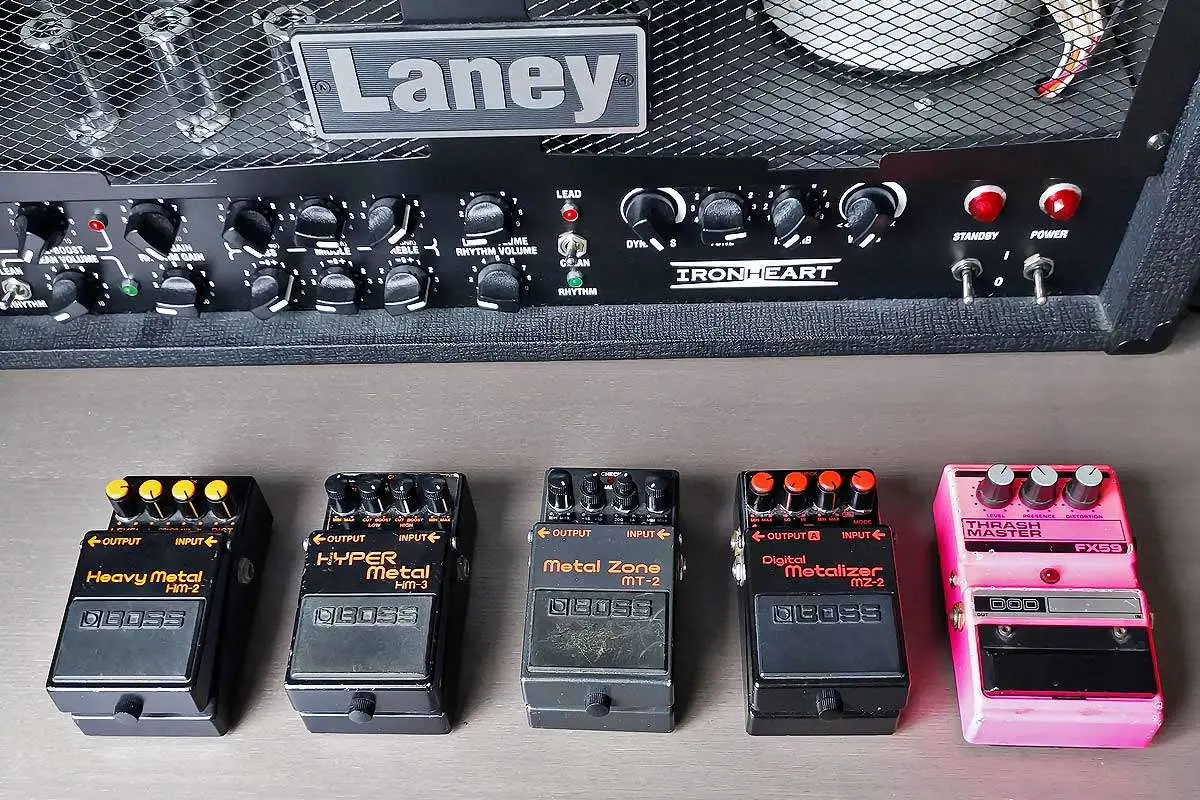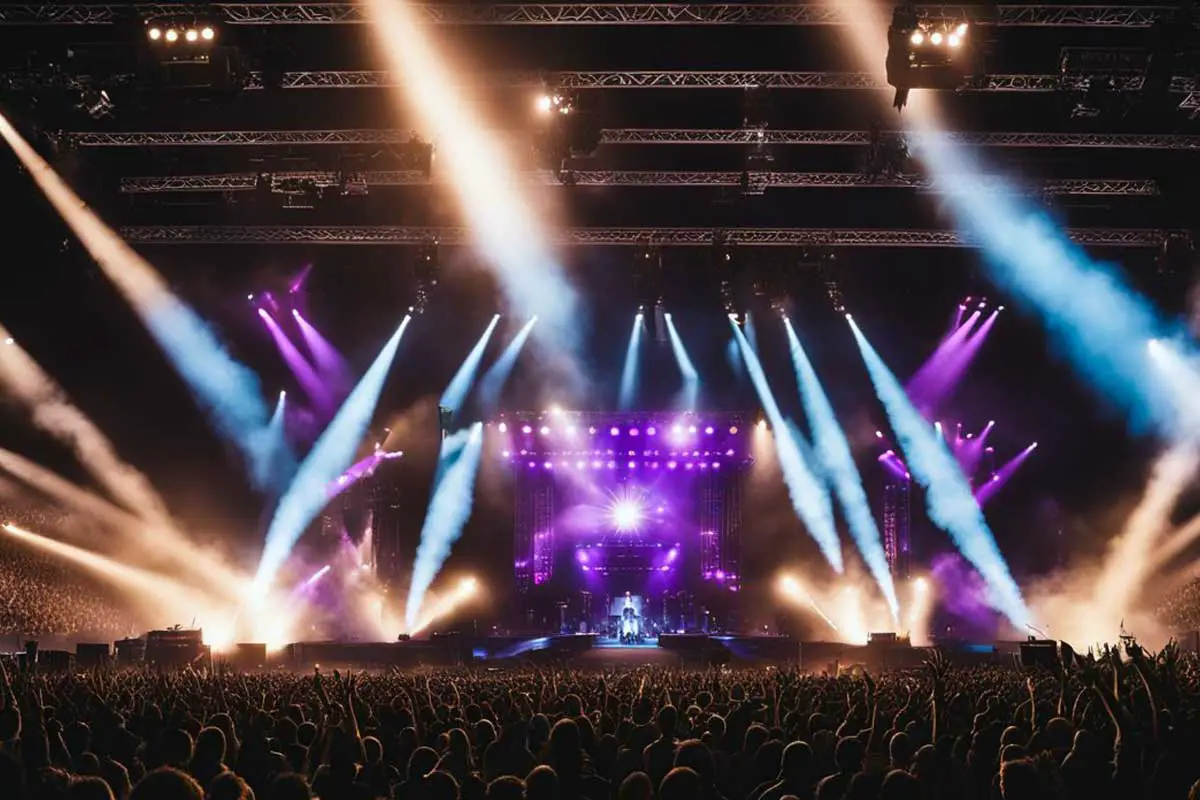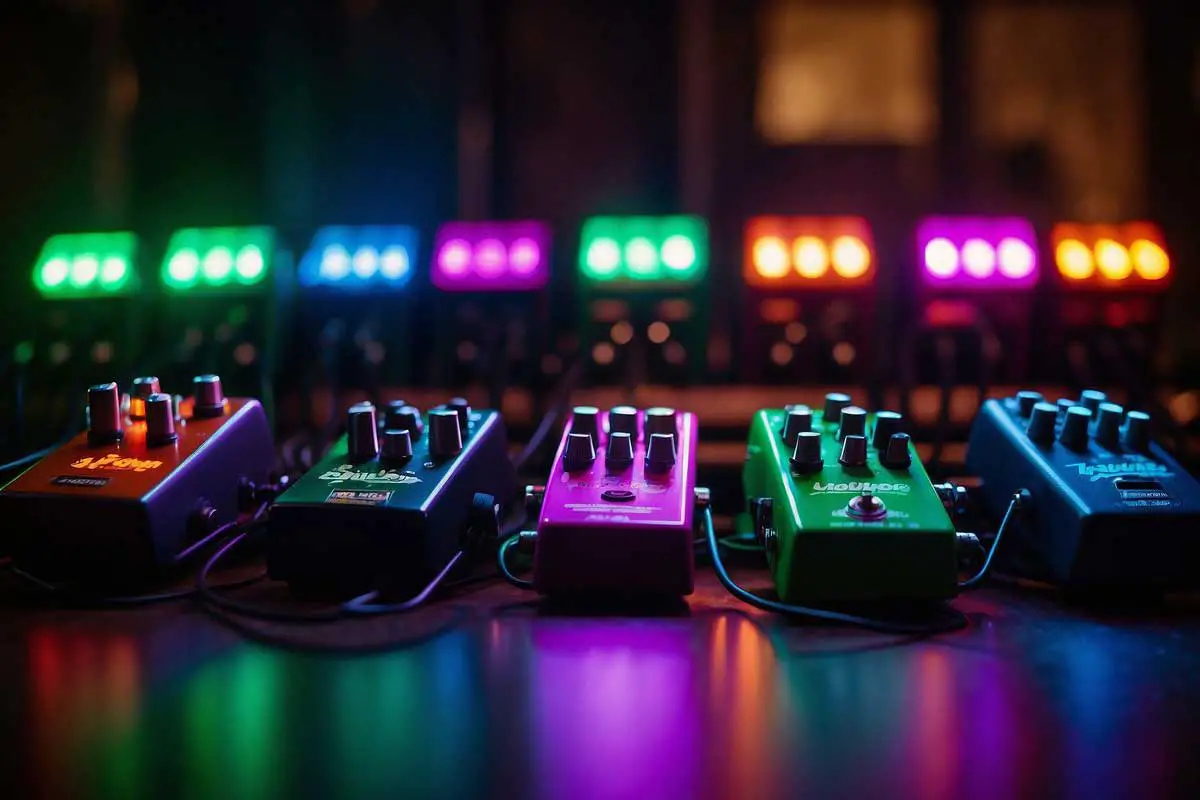Guitar pedals are an essential element for any player looking to achieve the aggressive & powerful sound characteristic of metal music. Your approach to creating the quintessential metal tone is often defined by the effects pedals you select. Choosing the best guitar pedals for metal is key, and can provide the clarity, distortion, and impact needed create crushing lows & searing solos.
Navigating the plethora of options, you’ll find that the best guitar pedals for metal are those that offer precision and high gain without sacrificing clarity. These can range from classic vintage pedals, which have stood the test of time, to modern multi-effects units that combine several pedal functionalities into one. Effects pedals like an overdrive can tighten your sound, while a good distortion pedal will be the backbone of your heavy tone.
Understanding the delicate balance between equipment and the sound you want to achieve is crucial. Whether it’s the warm growl of a tube screamer or the full-bodied chunk of a high-gain metal distortion pedal, your choices make a significant impact. It’s about finding that perfect blend where technology meets creativity, allowing you to express your unique playing style and musical vision.

The Essentials of Metal Tone
Creating the quintessential metal tone involves a delicate balance of equipment and knowledge. You’ll need to understand the intricacies of distortion and EQ, as well as how to properly stage your amp and gain for that powerful, aggressive sound you are after.
Understanding Distortion
Distortion is the heart and soul of metal tone. High gain distortion pedals amplify your guitar’s signal until it clips, producing a gritty and aggressive sound. This is essential for creating the thick, saturated tones reminiscent of a high-gain tube amp. Metal often leans on a specific type of distortion called “tight” distortion, which keeps the low-end punchy and articulate amidst the heavy gain.
The Role of EQ
The EQ (equalizer) is your sculpting tool, shaping the distorted signal to either cut through the mix or blend smoothly with other instruments. Boost your mids to maintain presence, and be careful with high EQ settings to avoid a piercing sound. Use a sweeping technique to identify problem frequencies and either cut or boost them to taste.
Amp and Gain Staging
Your amp is just as crucial as your pedals in achieving a metal tone. Solid-state amps often provide a more consistent distortion at different volumes, but many metal guitarists favor high-gain amps, especially tube ones, for their warmer, fuller distortion characteristics. Gain staging is key; set your amp’s gain high enough to get a good level of distortion but leave room for the pedal to push it into that thick, metal territory. Keep clean tones clear by balancing the gain with your guitar’s volume knob for dynamic playing.
Remember, a nuanced approach to distortion, EQ, and gain staging will put you on the path to achieving a metal tone that is both massive and refined.
Choosing the Right Pedals
When it comes to metal, your pedal choice can greatly influence your tone. Specific pedals can provide the aggressive distortion, tight dynamics, and clear articulation needed for metal music.

Distortion Pedals for Metal
Distortion is fundamental to metal, and selecting a pedal that delivers powerful, saturated tone is key. A Wampler Dracarys offers intense, modern distortion with ample control over tone shaping. Alternatively, the MXR Fullbore Metal is designed for the most extreme metal tones with a super tight response. The BOSS MT-2W Metal Zone is a widely recognized choice, renowned for its versatility and rich harmonic content.
Boost and Overdrive Pedals
Using a boost or overdrive pedal can enhance your metal sound by pushing your amp harder or tightening your tone when used in conjunction with distortion pedals. For a transparent boost that maintains your core sound, consider a pedal that simply increases gain without coloring your tone too much. When looking for an overdrive to pair with your distortion, options like the Friedman BE-OD can provide the extra edge and midrange emphasis ideal for metal rhythm and solos.
Related: Distortion vs Overdrive, What’s The Difference
Noise Gates and Suppressors
Noise gates are crucial for maintaining silence during pauses and suppressing unwanted feedback and noise in high-gain situations. A noise suppressor like the BOSS NS-2 can be particularly effective, allowing you to eliminate noise without affecting your playing dynamics. Integration of a noise gate in your pedalboard helps in achieving a professional level of sound control during both live performances and studio recordings.
Related: History of Guitar Pedals
Modulation and Ambient Effects
In the realm of heavy metal, your tonal palette can be vastly expanded through the strategic use of modulation and ambient effects that add depth, movement, and atmosphere to your sound.

Modulation Pedals
Modulation pedals like chorus, flanger, phaser, and tremolo shape your guitar’s signal by creating variable time delays, shifts in frequency, or rhythmic changes in volume. A flanger pedal can provide a swirling jet-like sound that can thicken your riffs or solos, while a chorus pedal duplicates your signal, slightly altering pitch and time to create a shimmering, multi-dimensional sound.
Phaser pedals create a movement that sounds like a sweeping notch is being carved through your tone, which can be used subtly for a gentle swoosh or dialed up for a pronounced effect. Tremolo pedals modulate the volume of your signal at a set rate and depth, useful for creating a pulsating effect that can range from subtle to choppy.
Reverb and Delay
Reverb and delay pedals are pivotal for creating ambiance. They can range from creating short echoes that give the impression of space, to vast soundscapes that add a sense of grandeur to your metal sound.
Reverb pedals vary in complexity from simple spring reverb sounds mimicking old amplifier tanks to expansive types of reverb pedals like plate, hall, and shimmer that can simulate massive spaces or even add pitch-shifted overtones to your reverb tails.
Delay pedals like the TC Electronic Flashback offer a spectrum of delay types, from tape and analog emulations to precise digital repeats. You can use delay sparingly to thicken your leads or in more pronounced settings to create rhythmic patterns and massive soundscapes. The types of delay pedals available provide you with a variety of choices, from simple slap-backs to complex, tempo-synced patterns.
Pedal Recommendations
If you’re looking to buy a pedal in any of these categories for your metal playing, check out the links below. We have some buying guides posted that include our top picks and offer various price points, some pedals having superb ratings & as low as $20.
The Best: Distortion Pedals – Boost Pedals – Overdrive Pedals – EQ Pedals – Chorus Pedals – Flanger Pedals – Phaser Pedals – Reverb Pedals – Delay Pedals – Pedalboards
Specialty and Signature Sounds
In the realm of heavy metal, specialty guitar pedals are integral for crafting unique tones that define your sound. From the sweeping howl of wah pedals to the guttural growl of fuzz distortion, these tools give you the power to stand out.
Wah and Expression Pedals
Wah pedals offer a dynamic form of expression, shaping your tone in real-time with the rock of your foot. Artists utilize these pedals for a vocal-like effect, creating a signature cry that cuts through heavy riffs with clarity. The wah pedal is especially associated with metal lead guitar, adding emphasis and character to solos.
Fuzz and Heavy Distortion
For a sound that’s synonymous with genres like doom and sludge, fuzz pedals lay the foundation. They produce a thick, saturated tone that ranges from a warm, vintage growl to a chaotic roar. Pedals such as the legendary ProCo Rat and Boss HM-2 are coveted for their ability to produce a consistent, powerful fuzz distortion that’s both aggressive and articulate, cementing their status in metal history.
Octave and Synth Effects
When you’re looking to add depth or an otherworldly dimension to your playing, octave pedals are the secret weapon. They generate additional tones above or below your original note, creating a fuller sound or mimicking a bass instrument. For experimental metal guitarists, these pedals can bridge the gap between traditional guitar sounds and the expansive territory of synth effects, allowing for more complex and creative compositions.
Metal Genres and Pedal Selection
When choosing pedals for metal genres, understanding the specific needs of each subgenre is crucial. Different pedals enhance the distinct characteristics of metal tones, and selecting the right one can elevate your playing to achieve the desired sound.
Classic Metal and Vintage Tones
In classic metal, the sound is characterized by a raw and powerful distortion reminiscent of bands like Black Sabbath and Pantera. For these vintage tones, opting for pedals such as the Pro Co Rat can provide you with the thick, crunchy sound that defines the riffs of this era. The Rat pedal is known for its ability to offer a range of sounds, from slight overdrive to full-on distortion, ideal for emulating vintage metal.
Modern Metal and Djent
For modern metal and djent, precision and articulation are key. Here, a tighter, more compressed distortion paired with extended-range guitars allows you to produce complex rhythms and palm-muted riffs. High-gain pedals with defined mids and lows work best, like the Boss Metal Zone, to achieve the signature modern metal crunch and clarity. This pedal’s parametric EQ allows you to sculpt the midrange that’s crucial for a cutting yet heavy djent tone.
Subgenres: From Doom to Progressive Metal
Within various subgenres, like doom or progressive metal, pedal selection becomes even more nuanced. Doom often relies on slower tempos with an emphasis on low-end and sustain; therefore, a fuzz pedal might suit your needs. For the intricate and varied sounds of progressive metal, you may find a versatile distortion pedal or even a multi-effects unit integral to capturing the genre’s essence.
- Doom Metal: Look for pedals that offer a dense, saturated fuzz to enhance long, heavy riffs.
- Progressive Metal: Choose pedals that provide flexibility and a wide array of tone options, assisting tech-savvy guitarists to invent new sounds and textures.
Remember, each pedal imparts unique characteristics to your tone, and experimenting is part of the process to find what truly resonates with your interpretation of metal.
Guitar Pedal Combos For Other Genres
When exploring guitar pedal combinations for various music genres, it’s essential to consider the specific effects that best complement each genre’s sound. Here’s a few more music styles to look into:
Pedals of Blues – Pedals for Country – Pedals for Funk – Pedals for Jazz – Pedals for Metal
